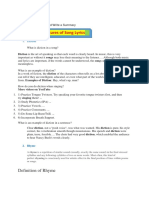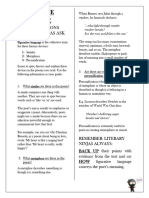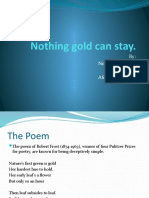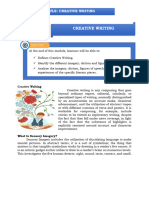Poetry Philippine Literature
Poetry Philippine Literature
Uploaded by
Darlene Kaye Labsan DimsonCopyright:
Available Formats
Poetry Philippine Literature
Poetry Philippine Literature
Uploaded by
Darlene Kaye Labsan DimsonCopyright
Available Formats
Share this document
Did you find this document useful?
Is this content inappropriate?
Copyright:
Available Formats
Poetry Philippine Literature
Poetry Philippine Literature
Uploaded by
Darlene Kaye Labsan DimsonCopyright:
Available Formats
PROCESSING THE MATTER
Poetry is generally considered to be the oldest of the arts. Long before our forefathers learned to write, they
sang and recited lines of verse.
Among the literary genres, poetry is the most closely related to music. Like, it appeals to the
senses and imagination. Like music, too, it is meant to be heard. Poets choose words for their sounds as
well as for their meanings. They combine these words to create vivid pictures and to express deep feelings.
Some of the best definitions of poetry:
1. Gemino Abad contends that “a poem is a meaningful organization of words.”
2. T.S. Eliot categorizes poetry as “the fusion of two poles of mind; emotion and thought.”
3. Manuel Viray states that “poetry is the union of thoughts and feelings.”
4. William Wordsworth says, “poetry is the spontaneous overflow of powerful feelings recorded in
tranquillity.
5. Edgar Allan Poe thinks, “it is the rhythmic creation of beauty.”
6. Percy B. Shelly states. “it is the record of the best and happiest moments of the happiest and
best minds.”
7. James G. Ong posits that “poetry is the ‘essence’ of the creative imagination of man.
ELEMENTS OF POETRY (Lacia)
Poems are literary attempts to share personal experiences and feelings. Since literature, in
general, is all about significant human experiences, poetry’s subject matter is also about the poet’s
personal life or the lives of those around him. Good poems, aside from being stated in a fresh manner,
often probe deeply and can contain disturbing insights. The language is fresh and demanding because
of its subtleties. Good poems show images which leave the reader a sense of delight, awe, and
wonder.
1. The Poetic Line.
The basic unit of composition in poems. An idea or feeling which is expressed in one line
and is frequently continued into the next line. This is called enjambment or run-on lines.
a. enjambment- the line that ends without a pause and continues into the next line for its
meaning
b. run-on- also, caesura. It is a strong pause within a line of poetry.
2. The Sound of Words.
An indirection prominent in the method of poetry is the use of sound effects to intensify
meaning. For the poet to convey ideas, he chooses and organizes his words into a
pattern of sound that is a part of the total meaning. These sound effects are the products
of organized repetitions. They are the following:
a. Rhyme repeats similar sounds in some apparent scheme.
Examples:
Under my window, a clean rasping sound
When the spade sinks into gravelly ground
- “Digging” by Seamus Heaney
Shall I compare thee to a summer’s day?
Thou art more lovely and more temperate:
Rough winds do shake the darling buds of May,
And summer’s lease hath all too short a date:
-“Sonnet 18” by William Shakespeare
b. Rhythm is the result of systematically stressing or accenting words and syllables.
c. Alliteration means the repetition for effect for initial vowels or consonants.
Example:
past the puffed-cheeked clouds,
she follows it, her eyes slit-smiling at the sun
d. Assonance refers to the correspondence of vowel sounds.
Example:
“I sipped the rim with palatable lip.”
e. Onomatopoeia is a long word that means simply the imitation in words of natural
sounds.
Example:
“Whoosh”
“Bow-wow”
3. Meter
It is the regularized and pattern rhythm. There are four conventional types of meter in
poetry written in English, each being distinguished from the others by the number and
accent of syllables.
a. Iambic meter. By far, the most popular and the most natural to English expression. Its
basic unit or foot is one unaccented and one accented syllable. ( _ / )
Example: Whose woods / these are / I think / I know.
b. Trochaic meter. The reverse of iambic meter. Each foot contains an accented and an
unaccented syllable. ( / _ )
Example: Swift of/ foot was / Hia / watha
c. Anapestic meter. Contains in each foot two unaccented syllables and one accented.
(__/)
Example: For the moon / never beams / with-out bring / -ing me dreams.
d. Dactylic meter. Opposite of anapaestic. It is slower and often is used to create a
strange mood. ( / _ _ )
Example: This is the / forest pri / -meval.
Seeing what the metrical units are and how many of them occur in the line is called
“scanning” a line of poetry. A one-foot line is called a monometer, two diameter, and
others in progression up to a seven-foot line; thus: trimeter, pentameter, hexameter, and
heptameter. Thus, the iambic line above is a tetramenter, and the dactylic line a trimeter.
4. Imagery
More than a visual detail, imagery includes sounds, textures, feel, odors, and sometimes
even tastes. Selection of concrete details is the poet’s way of giving his reader a sensory
image. By means of images, the poet makes the reader think about the meaning of the
poem.
5. Tone
Reveals the attitude toward the subject and in some cases the attitude of the persona or
implied speaker of the poem as well.
You might also like
- Module Grade 9 - Sound Devices in PoetryDocument17 pagesModule Grade 9 - Sound Devices in PoetryMaricel Rabang Rafal100% (2)
- ACT Subject Test English 1Document16 pagesACT Subject Test English 1IVNo ratings yet
- Sanskrit Meter 2009 Romanised TextDocument22 pagesSanskrit Meter 2009 Romanised TextGabe HiemstraNo ratings yet
- Poetic Devices Part 1Document7 pagesPoetic Devices Part 1Abdulrahman BaderNo ratings yet
- Lesson 3Document2 pagesLesson 3Mikhaella R. DerlaNo ratings yet
- Analysis of PoetryDocument64 pagesAnalysis of Poetryroel mabbayad100% (2)
- Poetic Devices ENGDocument10 pagesPoetic Devices ENGpiyumiNo ratings yet
- Canadian Poetry Student HandoutDocument18 pagesCanadian Poetry Student Handoutromil monisNo ratings yet
- Notes On PoetryDocument5 pagesNotes On PoetryRowena BartolazoNo ratings yet
- Online Phil. LitDocument12 pagesOnline Phil. LittangaroyvetteNo ratings yet
- PoetryDocument39 pagesPoetryEstepanie Gopet100% (4)
- Poetic DevicesDocument10 pagesPoetic DevicesMomina KhanNo ratings yet
- 21st-5-9Document24 pages21st-5-9Mikaela Sai ReynesNo ratings yet
- CNF Lesson 2 PoetryDocument22 pagesCNF Lesson 2 PoetryAlma Yumul BaltazarNo ratings yet
- The S.D Vidya School: Definition and Illustration of 10 Poetic DevicesDocument16 pagesThe S.D Vidya School: Definition and Illustration of 10 Poetic DevicesShubhodeep MandalNo ratings yet
- Lesson One Poetic DevicesDocument7 pagesLesson One Poetic DevicesNihad LaouarNo ratings yet
- PortfolioDocument23 pagesPortfolioChristian David Pecson100% (1)
- Poetic DevicesDocument9 pagesPoetic Devicesapi-262266786100% (1)
- Poetic Devices Are Literary Techniques Not Exclusively LimitedDocument8 pagesPoetic Devices Are Literary Techniques Not Exclusively LimitedLilibeth MalayaoNo ratings yet
- Elements of PoetryDocument19 pagesElements of PoetryMary Ann EsguerraNo ratings yet
- Chapters 1-2 SummaryDocument5 pagesChapters 1-2 Summarynabaa sadiqNo ratings yet
- كلية الاداب الادب للطلبة المرحلة الاولىDocument19 pagesكلية الاداب الادب للطلبة المرحلة الاولىhatemsami345No ratings yet
- English 9 Q21-4Document4 pagesEnglish 9 Q21-4Jamille GicoNo ratings yet
- 1.1 What Is Poetry?Document9 pages1.1 What Is Poetry?Ying YewNo ratings yet
- Poetry 1Document32 pagesPoetry 1Jellen GocoNo ratings yet
- Poetry (Features, Rhymed and Unrhymed)Document30 pagesPoetry (Features, Rhymed and Unrhymed)Jaymond Neil SubolNo ratings yet
- Elements of PoetryDocument3 pagesElements of Poetryrajahmati_28No ratings yet
- Poetry Introduction 2Document44 pagesPoetry Introduction 2Mariam SafwatNo ratings yet
- Understanding Language Feature of A SongDocument5 pagesUnderstanding Language Feature of A SongHana EkaNo ratings yet
- Module To Be EditedDocument40 pagesModule To Be EditedGallardo, Lourdes B.No ratings yet
- Aspects of PoetryDocument4 pagesAspects of Poetrytariqosman78692No ratings yet
- Creative Writing Week 1-8Document18 pagesCreative Writing Week 1-8Christopher YansonNo ratings yet
- Creative Writing MELC 2Document16 pagesCreative Writing MELC 2Scira SandejasNo ratings yet
- Group 2 TOL HandoutsDocument7 pagesGroup 2 TOL HandoutsFerdinand MelegritoNo ratings yet
- Poetry: Alcantara, R.LDocument26 pagesPoetry: Alcantara, R.LCJ Klein BautistaNo ratings yet
- Literary Device GlossaryDocument16 pagesLiterary Device GlossaryMokNo ratings yet
- Elements of Poetry Ni AllyDocument22 pagesElements of Poetry Ni AllybinibiningallysavalderramaNo ratings yet
- Literary Ninja Poetry Analysis Guide.203521719Document4 pagesLiterary Ninja Poetry Analysis Guide.203521719Menreet GergesNo ratings yet
- Poetic Devices, Structure and Forms of PoetryDocument22 pagesPoetic Devices, Structure and Forms of PoetryMuhammed AhmedNo ratings yet
- Reading A Poem Module 3 11 Stem CDocument58 pagesReading A Poem Module 3 11 Stem CRaen Kyle OlleroNo ratings yet
- POETRYDocument37 pagesPOETRYLerramie Dela Peña100% (1)
- Prose VS, Poetry, Types & Elements of PoetryDocument29 pagesProse VS, Poetry, Types & Elements of Poetrykristinevicente15No ratings yet
- POETRYDocument5 pagesPOETRYfadillahyunita0No ratings yet
- Nothing Gold Can StayDocument27 pagesNothing Gold Can Stayzuleka91No ratings yet
- Various Literary Devices 21st Century Literature From The Philippines and The World Sound DevicesDocument3 pagesVarious Literary Devices 21st Century Literature From The Philippines and The World Sound DevicesKarla Bernadette LugtuHonrado GonzalesNo ratings yet
- Creative Writing ModuleDocument8 pagesCreative Writing ModuleAgatsuma KylineNo ratings yet
- World Lit700Document4 pagesWorld Lit700rose sorsanoNo ratings yet
- 10 Sound Devices in Poetry With Examples What Are Sound Devices?Document16 pages10 Sound Devices in Poetry With Examples What Are Sound Devices?Ilang SafriatiNo ratings yet
- Ko PDFDocument12 pagesKo PDFMykii TagotiNo ratings yet
- UntitledDocument29 pagesUntitledKhemgee EspedosaNo ratings yet
- Creative WritingDocument5 pagesCreative Writingrod stephen intongNo ratings yet
- The Elements of Poetry: A Comprehensive Course for High Schools and Colleges: Understanding Poetry, #1From EverandThe Elements of Poetry: A Comprehensive Course for High Schools and Colleges: Understanding Poetry, #1No ratings yet
- About Poems and how poems are not about: and how poets are not aboutFrom EverandAbout Poems and how poems are not about: and how poets are not aboutNo ratings yet
- Dictionary of Literary Words: Vocabulary Building: English Word Power, #7From EverandDictionary of Literary Words: Vocabulary Building: English Word Power, #7Rating: 3.5 out of 5 stars3.5/5 (3)
- What Is RhythmDocument21 pagesWhat Is Rhythmbele yalewNo ratings yet
- AlexandrineDocument6 pagesAlexandrinenisay_life2255No ratings yet
- ديوان اشعار پروين اعتصامي Divan.ashar.parvin.etesameiDocument178 pagesديوان اشعار پروين اعتصامي Divan.ashar.parvin.etesameidddaaannn67% (3)
- A Course in Foot StructureDocument33 pagesA Course in Foot StructureMoises Enoc Perez AquinoNo ratings yet
- Sanskrit Metres of PoetryDocument13 pagesSanskrit Metres of Poetryshahshyam100% (1)
- The Canonization Form and MeterDocument3 pagesThe Canonization Form and Meterpriya royNo ratings yet
- Literary DeviceDocument5 pagesLiterary DeviceJane AmadNo ratings yet
- Delight in DisorderDocument9 pagesDelight in Disorderkpritom24No ratings yet
- Analyzing PoemDocument15 pagesAnalyzing Poemabc100% (1)
- 14 16 11 - 0 PDFDocument285 pages14 16 11 - 0 PDFLeonardo D AmadorNo ratings yet
- Poetry - Sound ElementsDocument21 pagesPoetry - Sound ElementstaynaracristinaNo ratings yet
- G09ENG2324 - PoetryDocument25 pagesG09ENG2324 - PoetryVenyNo ratings yet
- A Bike Ride PortfolioDocument3 pagesA Bike Ride Portfolioapi-252809548No ratings yet
- Module No. 4Document16 pagesModule No. 4Zarah CaloNo ratings yet
- Lit TerminologiesDocument71 pagesLit TerminologiesYadgar Fayaq SaeedNo ratings yet
- 1.examples of Metrical SystemsDocument5 pages1.examples of Metrical SystemsDiany SissiNo ratings yet
- ENGLISH 2 - Questions N AnswersDocument15 pagesENGLISH 2 - Questions N Answerssamwelnelson629No ratings yet
- PoetryDocument26 pagesPoetryEllaine Bianca CarriedoNo ratings yet
- PS - Elements of PoetryDocument70 pagesPS - Elements of Poetrygrace catunaoNo ratings yet
- Elements of Poetry PDFDocument6 pagesElements of Poetry PDFSumaira Malik100% (1)
- Elements of Specific Literary Forms-CwDocument38 pagesElements of Specific Literary Forms-CwEsther A. EdaniolNo ratings yet
- Creative WritingDocument18 pagesCreative WritinggermainejustincruzNo ratings yet
- Poetry DefinitionsDocument15 pagesPoetry Definitionsapi-265861168No ratings yet
- Challenges in Writing English Poetry For EFL StudentsDocument14 pagesChallenges in Writing English Poetry For EFL StudentsIskandar SulaymanovicNo ratings yet
- PWRHRH 1Document2 pagesPWRHRH 1api-203604001No ratings yet
- Sonnet: Shakespearean and PetrarchanDocument15 pagesSonnet: Shakespearean and PetrarchanGeraldine Natividad FacunNo ratings yet
- Shakespearean SonnetDocument19 pagesShakespearean Sonnetİrem ErginNo ratings yet
- Framework of Poem Analysis On Shelley's PoemDocument7 pagesFramework of Poem Analysis On Shelley's PoemQadeer AhmadNo ratings yet
- Download Complete The Saturnian Metre Analecta Gorgiana 1st Edition Wallace Martin Lindsay PDF for All ChaptersDocument67 pagesDownload Complete The Saturnian Metre Analecta Gorgiana 1st Edition Wallace Martin Lindsay PDF for All Chapterstrinhgolas3t100% (4)

























































































